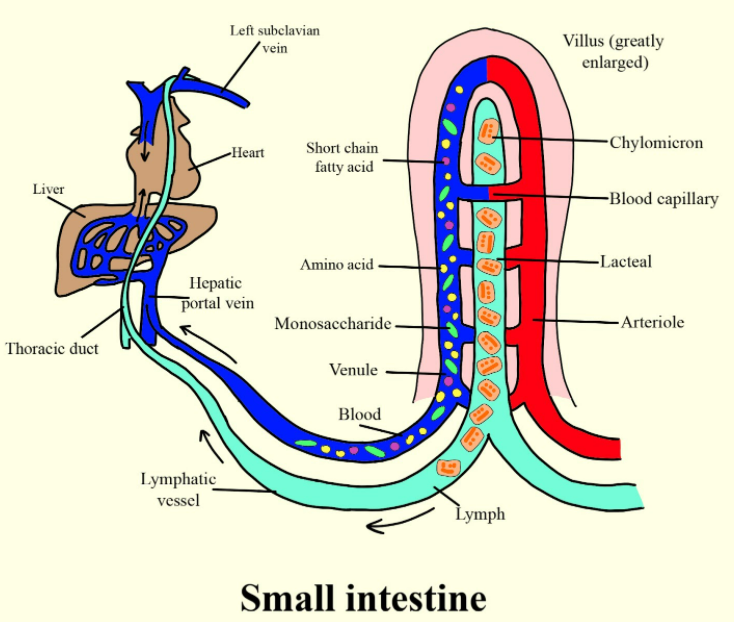
How many of the enzymes given below in the block belong to brush border enzymes?
Maltase, Nucleosidase, Enterokinase, Amylopsin, Steapsin, Nucleases, Erepsin, Carboxypeptidase, Lactase, Aminopeptidase.
A. Six
B. Seven
C. Five
D. Four
Answer
424.5k+ views
Hint: A set of digestive enzymes are secreted by the simple columnar cells lining the small intestine and these enzymes help in the terminal digestion of carbohydrates proteins and other molecules. They are all digestive enzymes.
Complete answer:
Brush border enzymes are the set of digestive enzymes that are secreted by the simple columnar cells with microvilli lining the small intestine and include the enzymes glucoamylase, maltase, phosphatase, enterokinase, lactase, sucrase, dipeptidase, erepsin, dextrinase, and nucleosidases. These enzymes are responsible for the terminal stage of digestion of dietary carbohydrates, proteins, and some other molecules that occur in the proximity of the small intestinal enterocytes. The enzymes are not secreted freely in the intestinal lumen but are tethered as integral membrane proteins in the plasma membrane of the enterocyte of the small intestine. The apical plasma membrane of these cells that contains these enzymes is composed of numerous microvilli extending from the cell and constituting the "brush border" of the small intestine. The microvilli of the small intestine have been shown below –

The distribution and density of the brush border enzymes are different in the segments of the small intestine and it has also been found that their abundance varies with the age of the animal.
So, the correct answer is ‘Four’.
Note:
In the terminal part of digestion, some dextrins, disaccharides, small peptides, nucleotides, phosphates, etc. are digested so the enzymes secreted will also be related to the digestion of these molecules.
Dextrins are the starch fragments that contain branching points for glucose linked in the 1,4 position while the nucleotides are ribose sugars linked to nitrogenous bases.
Complete answer:
Brush border enzymes are the set of digestive enzymes that are secreted by the simple columnar cells with microvilli lining the small intestine and include the enzymes glucoamylase, maltase, phosphatase, enterokinase, lactase, sucrase, dipeptidase, erepsin, dextrinase, and nucleosidases. These enzymes are responsible for the terminal stage of digestion of dietary carbohydrates, proteins, and some other molecules that occur in the proximity of the small intestinal enterocytes. The enzymes are not secreted freely in the intestinal lumen but are tethered as integral membrane proteins in the plasma membrane of the enterocyte of the small intestine. The apical plasma membrane of these cells that contains these enzymes is composed of numerous microvilli extending from the cell and constituting the "brush border" of the small intestine. The microvilli of the small intestine have been shown below –

The distribution and density of the brush border enzymes are different in the segments of the small intestine and it has also been found that their abundance varies with the age of the animal.
So, the correct answer is ‘Four’.
Note:
In the terminal part of digestion, some dextrins, disaccharides, small peptides, nucleotides, phosphates, etc. are digested so the enzymes secreted will also be related to the digestion of these molecules.
Dextrins are the starch fragments that contain branching points for glucose linked in the 1,4 position while the nucleotides are ribose sugars linked to nitrogenous bases.
Latest Vedantu courses for you
Grade 7 | CBSE | SCHOOL | English
Vedantu 7 CBSE Pro Course - (2025-26)
School Full course for CBSE students
₹ per year
Recently Updated Pages
Master Class 11 Economics: Engaging Questions & Answers for Success

Master Class 11 Business Studies: Engaging Questions & Answers for Success

Master Class 11 Accountancy: Engaging Questions & Answers for Success

Master Class 11 English: Engaging Questions & Answers for Success

Master Class 11 Computer Science: Engaging Questions & Answers for Success

Master Class 11 Maths: Engaging Questions & Answers for Success

Trending doubts
Which one is a true fish A Jellyfish B Starfish C Dogfish class 11 biology CBSE

State and prove Bernoullis theorem class 11 physics CBSE

1 ton equals to A 100 kg B 1000 kg C 10 kg D 10000 class 11 physics CBSE

In which part of the body the blood is purified oxygenation class 11 biology CBSE

One Metric ton is equal to kg A 10000 B 1000 C 100 class 11 physics CBSE

Difference Between Prokaryotic Cells and Eukaryotic Cells




